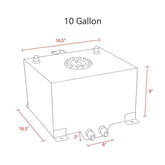Importance of the exhaust system in vehicle performance
The engine's exhaust system is in charge of eliminating the combustion byproducts. It contributes to the maintenance of appropriate engine performance and operation by effectively expelling these gasses. The best possible backpressure is ensured by a well-designed exhaust system, and this can directly affect torque, horsepower, and engine efficiency as a whole.
Components of a typical stock exhaust system
Let's investigate by taking a look underneath the vehicle. A standard stock exhaust system consists of several parts that cooperate to reduce engine noise. The exhaust manifold, catalytic converter, muffler, and exhaust pipes are the items we are discussing. They reduce noise, but inadvertently lower your car's potential for performance in the process.
Functionality of Exhaust Headers
The task of collecting and guiding exhaust gasses away from the engine falls to exhaust headers. The back pressure is caused by the shape of the exhaust manifold, the size of the exhaust pipes, and the existence of barriers. Their length and diameter have been specifically designed to enhance the flow of exhaust gases and reduce back pressure. Exhaust gases are then forced through the system by a wave effect that is created.
Its more angular design produces less resistance and turbulence. There is a more even distribution of exhaust gas flow because every cylinder has its own pipe. Exhaust headers may not be required for every vehicle, but they might be a wise investment for performance cars.
Do exhaust headers improve performance?
The fact that an exhaust header can enhance performance in a number of ways is one of the reasons you should think about purchasing one for your car. In order to ensure that you can enjoy your car for as long as possible, headers can assist various components within your car last longer.
Additionally, you can see the various speed gains associated with each sort of header, making it simple to achieve the desired improvements. Headers can enhance your car's performance in terms of horsepower, exhaust flow rate, and sound quality. There is an exhaust header available to meet your demands, regardless of the improvements you want to make to your engine system.
Pros
- Improve exhaust flow rate.
- Enhance your car’s sound.
- Eliminate exhaust system back-pressure.
- Increase horsepower.
- Enhance your vehicle’s look.
- Boost engine performance.
- Improve fuel economy.
- Prolong the engine’s life.
- Provide a weight reduction for your vehicle.
Cons
- Intensified noise
- More Costly
- Installation Issues
- Requires modification
- May void warranty
- Not compatible with all cars
How to Install?
Either a professional or you may install exhaust headers on your own. It is typically advisable to engage a professional because installation can be challenging and time-consuming. However, with the correct equipment and know-how, DIY installation is achievable. For cars that are used on a daily basis, a 3-muffler is a smart option because it can assist minimize noise without compromising performance. Installing the header exhaust requires the following actions:
- Cut the battery off.
- Old exhaust manifolds should be removed.
- Put the new exhaust headers in place.
- Use bolts or clamps to fasten the exhaust headers in place.
- Attach the sensors for oxygen.
- Put the battery back in.
- Check for leaks in the exhaust system.
Maintenance Requirements & Installation Challenges
Exhaust headers require regular maintenance to remain in excellent operating order. This entails washing the headers with a light soap and water solution and checking them for leaks or damage. Exhaust header maintenance requirements change based on the kind of header and the driving environment. Still, the following general maintenance advice is useful:
checking the headers on a regular basis for leaks or damage.
Using a water and mild detergent solution, clean the headers.
Driven through dirt or deep water should be avoided as this can harm the headers.
The following are a few possible difficulties with installation:
Gaining access to the exhaust and engine systems.
Removing and installing the old headers.
Connecting the new headers to the engine and exhaust system.
Leak testing of the system.









